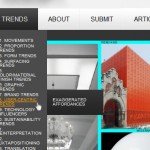About
Welcome to AWOL Trends, brought to you by AWOL Company!
This site is focused on providing inspiration via a curated database made by designers, for designers. We’ve been tracking design trends for several years, and will be releasing new ones each week until the entire database is populated. In order to ensure breadth across the design industry, we continuously track the Architecture, Transportation, Furniture, Fashion, Product, Graphic, Digital, and Fine Art categories. Follow us on Twitter to receive each weekly trend update.
Why was AWOL Trends started?
Working in consultancies, we’ve been exposed to many different types of aesthetics. Over time, this pool of stylistic themes becomes enormous. We thought it would be useful to compile and track them. But while there are countless design sites out there, creating a constant feed of new visuals, no one was making sense of the broader movements, the interconnections, and the deeper currents running through our aesthetic landscape. Currently, we’re tracking over 150 trends, but we know the world-wide creative community knows even more. So we created AWOL Trends as a resource for designers to share our knowledge, and also to provide a venue for members of the community to share their own. Another way to look at what we’re trying to create here is the world’s first “dictionary” for the many aesthetics used in modern design. Just as the culinary arts have recipe books, music has its books on musical theory, and our languages have dictionaries and grammar guides, the aesthetics of design needs a structure to draw from and build on: that’s fundamentally what AWOL Trends is all about. One of the early inspirations for AWOL Trends was the Barnes Collection in Pennsylvania, where objects of art are curated by their common theme rather than their period or nationality. Dr. Barnes was (and now we are) trying to find the unifying themes that run throughout the creative world.
What is a design trend?
A design trend is a visual theme that runs through various facets of creative culture. They usually have a beginning , being used in some example that sparks broader exposure, then gain wide acceptance across various product categories, and finally start to decline as the concept loses freshness. Some are short-lived (remember candy-colored iMacs?), some last a few years (remember silver paint?), and some last for decades (like Minimalism). Those with very long wavelengths we call “Movements”, because they’ve proven their longevity beyond just a few years. As a rule, we don’t follow fads (like faux-hawks) unless they mature into a trend and reach across different industries. Taken as a whole, this database of trends represents the full set of visual design themes that are currently in-use around the globe, specifically in Western design culture. Technically, each of our trends is an Aesthetic Mode of Visual Design for Western Culture. But AMVDWC is more confusing than “trends”. For more detailed information on design trends, check out our post: Trend Tracking 101.
How do I use AWOL Trends?
This is a resource for creative professionals. Think of these trends as tools for your aesthetic toolbox. Any design you see today will be a combination of these different stylistic modes. The trends on this site were designed to be used in the following ways:
1. For designers: use them as inspiration in your design process, combining them in novel ways to spark new aesthetic directions.
2. For creative directors: use these trends as tools to focus and guide your team’s explorations.
3. For design managers: use them to educate your internal project teams and other internal stakeholders as to the current state of design in order to better inform their decision making.
4. With clients: use these as an initial temperature-taking exercise to determine their general aesthetic preferences or visions for the project. Knowing the general stylistic direction for a project before concept exploration begins will allow you to use your time more efficiently, and focus your concepts more effectively.
5. For Educators: use this database to quickly familiarize your students with the world of contemporary visual design.
How are these trends organized?
Our trends are organized by the broad stylistic categories they fit into, located in a pull-down menu under the TRENDS tab at the top of the page. Each category contains several trends. These categories and trends are not industry- or category-specific, but reach across industries to establish a common theme. For example, there is no “Car Trends” category, but automotive references show up throughout our database. Also, all of these trends are current. Some have long-term staying power (see Movements), others are starting to show their age (see Declining Trends). You might say “I already know about Minimalism, that’s not new!” Don’t worry about whether these are new or not. Some have been in common usage for decades, some will be completely new to you. Our goal is to track ALL aesthetic trends: existing, declining, new, old, and especially the early signals. By using these stylistic modes, your concepts will be contemporary with the tapestry of visual themes that permeate our culture.
How can I contribute?
There are many ways you can help this effort. We’ve built a good start, but we know there are gaps in our database. AWOL Trends is intended to be an open-source resource, so we welcome the perspective and input of creative professionals around the world. Go to our SUBMIT page to learn more.
What are “Early Signals”?
Some aesthetic modes are so new that they’re not common knowledge. Others haven’t even landed yet, but have the potential to impact our visual landscape in the coming future. These nascent trends, or Early Signals, are accessible to our clients and design partners. To find out how you can access these cutting-edge aesthetic themes, inquire via our SUBMIT page.


